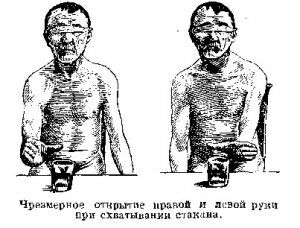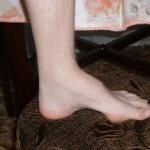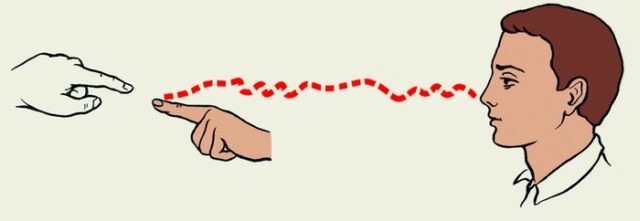 The dissymmetry with the Greek means negative particle + degree of measurement, that is, not the ability to determine the measure.
The dissymmetry with the Greek means negative particle + degree of measurement, that is, not the ability to determine the measure.
Dysmetry refers to the excess or insufficient amplitude of the directed movements of the limbs of the body.
In other words, a person can not exactly hit a certain target, loses the sense of space, can not "by eye" determine the distance, accurately produce motor functions.
Types of disorder
Dysmetry is of two types:
- hypermetria;
- hypometry.
When the goal is unattainable
Hypermetry is manifested in a person's inability to determine a measure in the amplitude of movements. For this reason, the fulfillment of some of them is either very difficult or even impossible.
A person can not touch the target, since its location seems to him far beyond the real. Hypermetry can manifest itself, as in separate movements of fingers, hands, feet, and when walking.
The movements of the patients are particularly sweeping( the step becomes wider, the writing changes to the larger side, the movements are less accurate).
When to reach the target with the hand
 Hypometry is characterized by the complete opposite of hypermetry. It is also difficult for a person to determine the real dimensions of objects, to coordinate the amplitude of movements.
Hypometry is characterized by the complete opposite of hypermetry. It is also difficult for a person to determine the real dimensions of objects, to coordinate the amplitude of movements.
In this case, the patient will move towards the desired goal, but her location will be much closer than the actual one. Thanks to this factor, the patient's movements will be more accurate, with minimal sweeping.
The hypometry is also manifested in the movements of the fingers, hands, feet and walking, which means that all accompanying movements will be appropriate.
When an
disorder is manifested Dysmetry is manifested in cerebellar ataxia. The reason for this is the absence or defeat of one of the deep cores of the cerebellum, which are responsible for the directed movements of the limbs.
In this case, there is either a reassessment of the range of the location of the target, or an underestimation( that is, the person either "wiggles" or "does not reap").
The disorder can develop not only because of damage to the cerebellar nuclei, but also because of the damage to the spinal cord, responsible for incoming feedback. This process is necessary to assess the time of the end of the movement.
In drawing a conclusion, it can be said that these two bodies are interrelated in a functional sense.
One sends a signal to the muscles to perform certain actions, the other - reads information about the action itself and sends it back to the cerebellum, so that the latter sends a signal about the termination.
 The failure of at least a significant part of one of these organs leads to imminent temporary or permanent dismetry.
The failure of at least a significant part of one of these organs leads to imminent temporary or permanent dismetry.
To determine the type of disorder in a potential patient, a number of test observations are conducted, based on the results of which a diagnosis is made.
When diagnosing dismetry, the patient will be offered a series of exercises with the help of which the specialist will understand the type of disease.
 What to do and how to live a person whose amyotrophy Sharko-Mari. More detailed in our material.
What to do and how to live a person whose amyotrophy Sharko-Mari. More detailed in our material.
How to stop the sympathetic-adrenal crisis you can find out by reading our article. Also in the material about the main provoking factors.
What indicates the development of the disorder
Samples for dysmetry:
- Paltzosovaja .The patient is offered to take a comfortable position, to straighten his erect arms to the sides and alternately try to touch the index finger to the tip of the nose. During the test, the expert assesses the accuracy of the hit, takes into account the smoothness of movements, as well as the presence of intentional tremor( limb trembling when approaching the target).The same test can be complicated by holding it with your eyes closed.
- Fingerprint .The principle of carrying out is similar to the previous one. The patient takes a comfortable position, spreads his hands and tries to hit the tip of the index finger with the finger of the examiner. All the same factors are evaluated as in the first case.
- Indicative .The specialist is in front of the patient face to face, in front of him holding a neurological mallet. With a periodicity of several seconds, the doctor changes the location of the hammer, moving it in the air, "drawing" the segments in different directions. The patient's task is to "catch up" with a finger with a hammer. So there are studies on hypermetry, intentional tremor and on a falling victim.
- Heel-knee .The patient lies on his back, raises one leg up and with the heel of the raised leg should touch the knee located on the lying leg. After that, without the pressure, hold the same heel from the knee to the ankle. The test allows you to determine the past loss, jerking, intentional tremor and discontinuity of movement.
- The Schilder test .The patient raises one arm straightened in the elbow, the other holds directly in front of him, horizontally the floor. After that, he must lower his raised hand to the level of the second hand. The test is conducted with closed eyes. If the hand falls below the required level, hypermetry is diagnosed, and hypometry is higher.
- A sample of the absence of a "back shock ".The patient should try to squeeze his hand in the elbow parallel to the floor( brush "looks" at the chest), but in this he is severely hindered by the assistant. With an unexpected termination of resistance, the patient strikes himself in the chest, while a healthy person would have an antagonist muscle.
- Assay for adioadichokinesis .The patient must stretch his arms in front of the trunk and consistently perform supination and pronation of the limbs. In this test, slowness, awkwardness, and excess movements of the limb can be seen, from which the focus of the cerebellar lesion is manifested.

These are the main ways to determine the dissymmetry in a potential patient. As you can see, they can be easily carried out at home with the help of native people.
If deviations occur, it is recommended that you consult a specialist for a complete examination and diagnosis. Only with his skilled help you can know for sure the state of your health.



